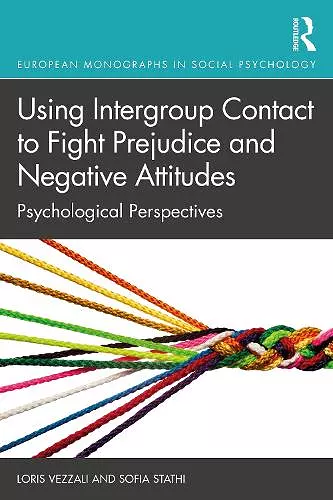Using Intergroup Contact to Fight Prejudice and Negative Attitudes
Psychological Perspectives
Loris Vezzali author Sofia Stathi author
Format:Paperback
Publisher:Taylor & Francis Inc
Published:13th Nov '20
Currently unavailable, and unfortunately no date known when it will be back
This paperback is available in another edition too:
- Hardback£145.00(9780815353461)

In this groundbreaking volume, Vezzali and Stathi present their research program within the larger contact literature, examining classic theories and current empirical findings, to show how they can be used to reduce prejudice and negative attitudes.
The contact hypothesis (Allport, 1954) posits that in an environment of equality, cooperation, and normative support, contact between members of distinct groups can reduce prejudice. Whilst considerable research supports this hypothesis, how theory can be tested in the field remains relatively unexplored. In this innovative book, Vezzali and Stathi discuss why relying solely on advancing theory without considering applied aspects integral to contact may limit the scope of contact theory and restrict our understanding of complex social phenomena. Exploring fascinating topics such as the role of contact in reducing implicit prejudice and fostering collective action, applying indirect contact, and promoting positive interactions among survivors of natural disasters, Vezzali and Stathi explain how contact theory can be implemented and enhance the societal impact of intergroup contact research.
Featuring extensive discussion on intergroup contact literature, future directions, and the necessity of applied research, this book will be essential reading for both students and academics of social and behavioral psychology.
"This important and wide-ranging book illustrates the enduring value of intergroup contact for reducing prejudice, ranging from face-to-face contact to ‘contact’ via the media. But it also applies the theory and research to new domains – such as promoting better intergroup relations among survivors of natural disasters – and sets out an exciting blueprint for how to apply this approach more effectively in interventions, especially in schools." - Miles Hewstone, Emeritus Professor, University of Oxford, UK
"More than a thousand studies and multiple meta-analyses have solidly established intergroup contact theory. Now social psychology needs a fresh review of this vast literature, suggestions for new directions and better means for applying the theory to "the real world." Vezzali and Stathi meet all three of these needs handsomely in this book." - Thomas Pettigrew, Professor Emeritus, University of California, Santa Cruz, US
"This volume, which is co-authored by two internationally recognized scholars and leaders in the study of intergroup contact, offers not only a comprehensive review of the relevant literature but also an insightful analysis and integration of the extensive work on this topic. The volume is logically organized, comprehensive in its scope, grounded solidly in relevant theory, sensitive to issues of practical implementation and constraints, and enlightening in how it identifies novel and important directions for future research. It is a “go-to” resource for anyone wanting to learn more about how to improve intergroup relations through intergroup contact and an authoritative resource for students and researchers already invested in this topic. Drawing to a substantial degree on their own important and innovative research, the authors highlight how indirect forms of contact, such as learning about or observing others’ intergroup interactions, such as through the media, can play a profound role in combatting bias and creating stable, positive, and productive relations between groups. The book is timely, socially and theoretically. It is also forward-looking and innovative; the authors have set a promising agenda for both research and practice in this area for many years to come." - John Dovidio, Professor, Yale University, US
'This volume, which is co-authored by two internationally recognized scholars and leaders in the study of intergroup contact, offers not only a comprehensive review of the relevant literature but also an insightful analysis and integration of the extensive work on this topic. The volume is logically organized, comprehensive in its scope, grounded solidly in relevant theory, sensitive to issues of practical implementation and constraints, and enlightening in how it identifies novel and important directions for future research. It is a “go-to” resource for anyone wanting to learn more about how to improve intergroup relations through intergroup contact and an authoritative resource for students and researchers already invested in this topic. Drawing to a substantial degree on their own important and innovative research, the authors highlight how indirect forms of contact, such as learning about or observing others’ intergroup interactions, such as through the media, can play a profound role in combatting bias and creating stable, positive, and productive relations between groups. The book is timely, socially and theoretically. It is also forward-looking and innovative; the authors have set a promising agenda for both research and practice in this area for many years to come.' - John Dovidio, Professor, Yale University, US
'This important and wide-ranging book illustrates the enduring value of intergroup contact for reducing prejudice, ranging from face-to-face contact to "contact" via the media. But it also applies the theory and research to new domains – such as promoting better intergroup relations among survivors of natural disasters – and sets out an exciting blueprint for how to apply this approach more effectively in interventions, especially in schools.' - Miles Hewstone, Emeritus Professor, University of Oxford, UK
'More than a thousand studies and multiple meta-analyses have solidly established intergroup contact theory. Now social psychology needs a fresh review of this vast literature, suggestions for new directions and better means for applying the theory to "the real world." Vezzali and Stathi meet all three of these needs handsomely in this book.' - Thomas Pettigrew, Professor Emeritus, University of California, Santa Cruz, US
ISBN: 9780815353485
Dimensions: unknown
Weight: 1060g
198 pages